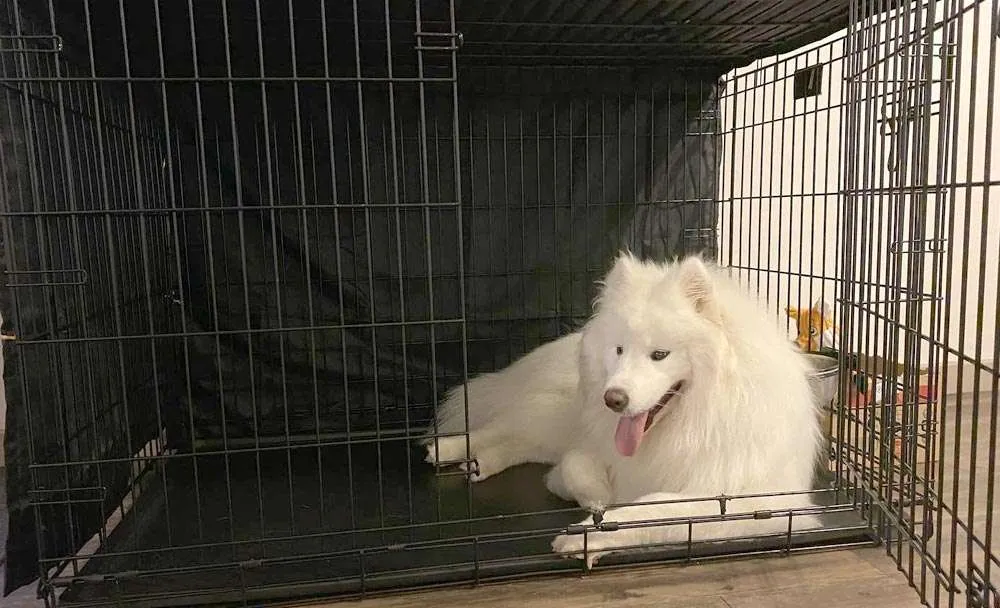So, you have a Samoyed dog and have heard a lot about crate training but still have many questions.
You want to know how to crate train your Samoyed and if it’s cruel or worth it.
All these can be intimidating for you. This post will provide a guide on crate training your Samoyed. Let’s get started.
What is crate training a Samoyed?
Crate training is training your Samoyed to be comfortable in confinement.
In the wild, dogs find safety in dens during pregnancies and when they raise a litter.
These litters grow up to feel comfort and safety in the dens.
Crate training your Samoyed teaches them to relieve this part of their nature and be content under confinement.
A Samoyed can initially find the whole idea stressful and feel anxious about it, but if done well and with patience, it can get used to it and eventually like it.
A step-by-step guide for crate training your Samoyed
Crate training your Samoyed isn’t a one size fits all thing. The steps and instructions vary based on the age and temperament of the Samoyed.
Some Samoyeds are more challenging to train than others and can take as long as a year to get used to their crate, while others can feel comfortable in their box in just a few weeks.
Age can also be a determinant. Crate training a puppy will differ from how you would crate train an adult Samoyed.
Crate training a puppy Samoyed
It is easier to train a puppy Samoyed due to its size and easy temperament.
You shouldn’t start crate training your puppy until the 6th month.
You should only introduce more outstanding training after this period. If you can’t be consistent, I advise you not to start.
Here’s a step-by-step guide to crate training your Samoyed puppy.
1.) Introduce your Samoyed puppy to the crate.
The first thing to do is place the crate in a familiar spot in the house, preferably somewhere the family spends a lot of time.
Place a comfortable blanket in the crate and open the door. You can also introduce a toy in the container and open the door.
Place your puppy close to the crate. If it is curious, it will enter the box to explore. If not, you can throw in a treat to encourage it to go inside.
You can also play with the toy inside the crate to encourage the puppy to go inside.
2.) Put food inside the crate.
Puppies love to eat and will always look forward to doing so.
After you introduce the crate to your puppy, you can start placing its food in the crate or near the entrance of the crate.
Do not try to force the puppy to eat inside the crate.
Instead, put the food beside the crate opening and slowly push it deeper into the crate every day until it is now fully inside.
Once the puppy is entirely inside and eating, you can close the gate.
Do this for two days, but open the door immediately after the puppy has finished eating.
You can increase the period the gate is closed with each day.
Do not be too eager to open the gate when your Samoyed starts whining or crying.
If you do that, it will believe that crying will always get you to open the gate.
3.) Leave for more extended periods.
Once your puppy stays in the crate for 10 minutes without whining, you can start practicing, leaving him in the box without supervision or being around.
Try not to do a little too much from the start.
I recommend you stay around the room doing things so the puppy can have you in sight.
Seeing you around can help it heal comfortably and securely in the crate. Do not leave your puppy unattended for long.
Leaving your dog for an extended period can make him whine.
After a while, you can start leaving the room. Leave the room for 10 minutes at a time, increase to 20 minutes, and then 30-minutes later.
Always be careful to follow this pattern. Do not suddenly leave your Samoyed dog for hours, as this can disrupt the training.
Make it incremental with each passing day.
4.) Keep the goodbyes short.
When leaving your dog, do not waste too much time saying goodbye to the Samoyed puppy.
Prolonged goodbyes can make your puppy feel like you’re abandoning him or leaving for an extended period, leading to more whining.
Crate training for adult Samoyed
Crate training an adult Sammy is the same as crate training for a puppy Samoyed, safe for additional tips.
Follow the same steps for training a puppy.
To supplement that, get a bigger and stronger crate that can withstand the weight of an adult Samoyed.
Crate training an adult Samoyed can take longer because they have already set their ways.
And once you start, do not show excessive sympathy when leaving it in the crate.
Instead, stay calm, encourage your Sammy from a distance, and slowly leave the room.
How long does it take to crate train a Samoyed?
It depends on the dog, its age, and its peculiarities. All things being equal, you can crate train a Samoyed within six months.
You can train a puppy in a shorter period, and an adult will take more time, sometimes up to a year.
How long should you keep your Samoyed in a crate?
My advice is that you shouldn’t keep your adult Samoyed in the crate for more than 7 hours a day and should not confine a puppy in the box for more than 5 hours.
Where to place your Samoyed Crate?
The best place to place your Samoyed crate is somewhere that is visible to everyone and has no obstruction.
Always put it away from direct sunlight and close to a cooling device or an air conditioner.
Remember, Samoyed doesn’t like hot temperatures.
The importance of crate training your Samoyed
Most pet owners are busy and need to leave the house to work or run errands.
Crate training helps you keep your dog safe and comfortable for long periods while you engage in other activities outside the house.
It also keeps your Samoyed from damaging things in the house or creating a mess in your absence.
It can also help with easy transportation when traveling. Occasionally, dogs go to their crate when injured or need to rest.
What to put in a crate?
Do not try to do too much and buy many toys in the crate.
Too many toys can overwhelm your Samoyed.
Instead, place their favorite toy in the crate.
If a puppy cannot control its bladder, I advise you get a washable waterproof bed.
Conclusion
I believe you must have learned how to crate train your Samoyed pets now.
While it depends on the dog’s age and personality, specific tips remain universal.
Featured Image © Happy The Samoyed (Facebook)







